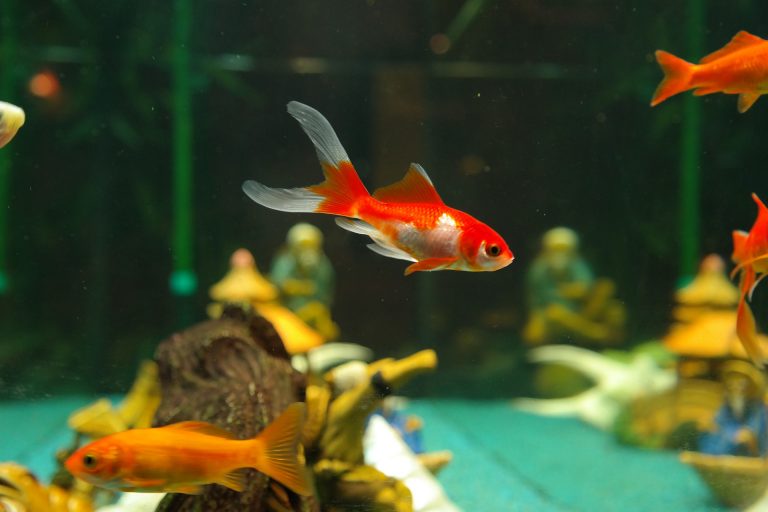A Simple Overview On The Different Types Of Goldfish
Goldfish are a type of fish that is commonly kept in aquariums. They are bred for different colors and shapes and make excellent choices for a variety of different aquarium setups.
Goldfish can be found in many different colors and shapes.
The history of Goldfish is very fascinating. Learn how from being food in China, Goldfish became a much-loved pet in London and then across the world from my article How Did Goldfish become Our Pets?
Common Goldfish
As the name suggests, single-tailed goldfish have a single caudal fin. This is normally social and loves having lots of room to swim around. The single-tailed species are hardy goldfish that are often kept in ponds with larger specimens of the same type, particularly if they have fewer fins, or in mixed communities.
They need to be kept in groups of at least 6 or more because they can become aggressive as they compete for food and territory. They have a long lifespan that can reach 10 years old. They also thrive very well on a diet consisting mostly of flake foods and dried peas.
Telescope Eye (also known as “veil-tail” or “racing-type”)
The telescope goldfish stands out from the rest because of its large, bulged eyes that give the fish a “wild-eyed” appearance. The telescope goldfish has a fish with a large head and bulging eyes.
The body of the telescope goldfish is slimmer than other types of goldfish, such as the veil tail (or racing-type). As an adaptation for swimming in open water, the telescope goldfish has elegant tail fins that are not used for propulsion but to create turbulence so that it can escape from predators more easily.
Bubble Eye (also known as “Popeye”)
Bubble-eyed goldfish have fluid-filled sacs under their eyes that give them a bubble effect. Some people find it particularly relaxing to watch them swim. If you’re looking for a new family member, then you’ll have plenty of choices.
Celestial eye (also known as “half moon”)
Celestial eye goldfish are much like telescope goldfish, but they also have no dorsal fins, and their bulging eyes are always pointing upwards.
Despite their vision limitations, they are agile swimmers. You need to pay attention to them since they also have fragile eyes which require special care.
They are unable to compete with more active goldfish for food. Sharp ornaments and objects are not advised in an aquarium. Keeping them with other limited-vision breeds such as Bubble Eye Fish is best. They also should not be in the same tank as other fish due to their sensitivity.
Lionhead goldfish
Lionhead goldfish do not have dorsal fins, but they often have a single wen on the top of their head.
They cover the top of the skull, leading to a lion-like appearance. Furthermore, it has been named after the mythical beast.
Pompom goldfish
The most distinctive feature of a goldfish is the growth located in its nostrils. There is no dorsal fin and an egg-shaped body. The pompom’s body shape is without a dorsal fin.
The Chinese submit this variety as the “Velvet ball”. Records of this fish’s existence date back as far as 1898. The first time these fish were imported into the UK was in 1936 when they were exported from Shanghai and displayed at an aquarium in Paris. Pompom Goldfish was hugely popular for a while, but are now more rarely seen on display.
Comet goldfish
The Comet goldfish, also known as the Papaya comet, has evolved to have a more streamlined look than its ancestors. They are said to be a cross between a common goldfish and a traditional comet goldfish.
Comet goldfish are distinguishable from common goldfish by the more elegant, slimmer body and larger fins. But just like the common goldfish, they have a single tail.
They have a tail that stands out compared to most other fish. Comet tails can be either the same length as the body or they can be longer than the body while goldfish tails are in-between these lengths.
Hence their name, ‘comet goldfish’ as their tail depicts a comet’s tail.
Oranda goldfish
Oranda sport a fleshy cap at their heads and come in different colors that draw in many aquarists. These fish are peaceful and can coexist with others of the same size.
They typically grow around 8-9 inches long but can grow much larger if the individual has particular genetic qualities and tank conditions.
The largest Oranda Goldfish was bred in Hong Kong and reportedly measured 14 inches in length.
Ryukin goldfish
Ryukin Goldfish are one of the rare goldfish species around. Ryukin belongs to a subset of fish called ‘Fancy Goldfish’.
They have heavily bred in Asia to get the final look we have today.
Ryukin is a popular, low-maintenance fish species that are perfect for well-managed aquariums and ponds.
They grow a hump on their shoulders once they mature. They typically remain around 6 inches long but can grow bigger if they’re living in a well-maintained and larger pond or water body.
With the right care, these fish can live for up to 20 years. Their average lifespan is 10-15 years.
Shubunkin goldfish
Shubunkin Goldfish are divided into three different groups, America, Bristol, and London Shubunkin.
Each group looks almost the same and also has similar care requirements. But the average person cannot tell them apart as they have subtle differences
The London Shubunkin Goldfish are the most common type of this goldfish. They’re typically very short in height and have a slender build. Fins are also usually more round.
American Shubunkin goldfish have a long tail with a deep, dramatic fork that looks like the tail of a Comet goldfish. Quite some people believe that American varieties are the closest to the original, Japanese Shubunkin.




One Comment
Comments are closed.